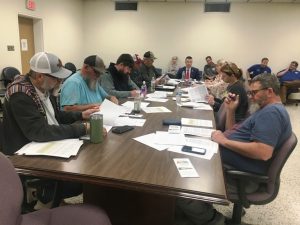The county budget committee has completed its budget preparation for the 2025-26 fiscal year except for setting the debt service property tax levy.
During Tuesday night’s meeting, the budget committee approved the ambulance service and 911 budgets as well as an appropriations resolution and a capital improvement plan for current and future debt management but delayed action on setting the tax levy until after the jail committee meets next Monday, June 16 at 6 p.m. in the auditorium of the county complex where a recommendation could be made on the next step toward building a jail.
The current tax levy is $2.51 per $100 of assessed value which includes a debt service tax levy of 0.6160 cents. For now, the 51-cent tax increase from last year remains in the proposed 2025-26 budget but that could change by the next budget committee meeting before the final consolidated budget is submitted to the full county commission for adoption.
Steve Bates, the county’s fiscal agent, is recommending that the county keep the debt service levy the same as last year to fund a new jail and for the future construction of a second new school. According to Bates, if a jail is funded through a 12 year note rather than a 20-year bond, the county would save as much as $8 million in interest. Bates gave specifics when asked by budget committee member Tony Luna Tuesday night.
“Have you ever done the math on a 12 year note versus a 20-year bond? What is the difference in how much interest we’re paying”, asked Luna.
“Yes, let’s take the $35 million (jail construction option) you’re going to pay $44, 604,000 on the note or $53,100,000 on the bond. That’s $8,496,000 difference for eight years. That’s over a million dollars a year,” said Bates.
“Could you redo a note if interest dropped,” asked Budget Committee Chairman Jeff Barnes.
“Sure,” responded Bates.
“Can you also do that on a bond”, asked Barnes.
“Yep”, said Bates.
“What you would do is put call provisions on both of them. Typically, when investors buy a bond, they want to know if they are going to have that generated income for “x” number of years. You would probably put a 10 year call on a bond or on that note you could probably put a seven-year call or maybe five,” Bates explained.
“To reiterate, we could save the county over $8 million on a 12 year note versus a 20-year bond,” asked Luna.
“Yes”, replied Bates. “Because the further you go out the yield curve the higher the coupons get,” he added
Last week, the budget committee discussed new jail cost estimates provided by Bell Construction. When comparing the 152 bed versus 200 bed options, Bell concluded that jail construction on a new site would be from $8.6 million to $9.3 million cheaper. No cost numbers were apparently provided on the existing county property with the adjoining lot not owned by the county.
According to Rick Bruining of Bell Construction the pricing recap for the four scenarios on the DeKalb Jail Project are as follows:
*New site: 152 beds: $28,200,000
*New site: 200 beds: $34,500,000
*Existing site: 152 beds: $36,800,000
*Existing site:200 beds: $43,800,000
According to Jail Committee Chairman Larry Green, a new jail on the existing site would be a two-story structure as opposed to a one level building at a new location. More employees might also be needed to staff a two-level jail to meet state requirements.
County Mayor Matt Adcock said the Bell proposal for the existing site makes use of the property the county already owns leaving an option for future expansion on an adjoining lot the county currently does not own.
The new proposal has not been reviewed by the Tennessee Corrections Institute which has to certify it nor has Sheriff Patrick Ray had input.
There are still a lot of things missing like an armory, impound lot, evidence room, detective offices, etc. so there are still some questions on what that building would look like, “said County Mayor Adcock.
Bates presented to the budget committee last week assumptions on a jail debt service requirement on $29 million, $35 million, $37 million, and $44 million doing either 12-year notes, 20-year bonds, or 25-year bonds.
According to Bates, the debt service requirement on a new jail over 12 years would be $3, 080,000 on a $29,000,000 project; $3,717,000 on a $35,000,000 plan; $3,930,000 for a $37,000,000 option; and $4,675,000 on a $44,000,000 option.
“You could issue 12-year notes, get the jail out of the way, and then fund school #2,” said Bates. “Remember the 51 cents was never going to fund the judicial center on its own last year. It never was going to fund it alone. It was the fact that you have over $600,000 freeing up in debt service together with that money which was going to fund the project but that was defeated,” explained Bates.
“It goes back to the 12-year note. It depends on where you want to go from here. If you want to lower the tax rate in the future, then you’ll have to step up to the plate. You may not want to do it but that’s where you are at. What are you going to do? In 10 or 12 years another county commission is going to come in and have the same problem to fund school #2. Are they going to take the money that’s freed up together with contributions from local purpose and contributions from the general-purpose school fund to try to fund school #2? Or will they have a wheel tax if there is a shortfall? It’s going to be the same problem in 10 or 12 years. But I can tell you by doing the 12 year note your tax rate in the long term is going to be lower, longer. That’s the trade-off,” Bates continued.
“Look how much revenues are exceeding expenditures in 2034, by $4,219,000. If you did $7 million 30-year bonds in that year your debt service requirement would be $4, 225,000 if they could build a school for $70 million. You’re going through reappraisal next year and the tax rate is going to come down to at least $1.49 or thereabouts. You’ll go through reappraisal again in six more years. If your sales ratio is .88 you’ll come in at about $1.31 tax rate. I think we can keep a lid on expenditures until then. If we can’t then we’ll have to shift money from capital projects. We have excess money from interest income going to capital projects now and we could shift it back to the general fund to get us by. The longer you can play that game the lower your tax rate is going to be. I guess it just depends on what you think it’s worth to save a couple of pennies on your tax rate now versus 12- or 20-year bonds. If it’s just a couple of pennies you are better off doing the 12 years and being done with it. If it’s going to be 20 years, then I suggest you adopt an initial bond resolution at June’s meeting and see if you can even do bonds. You don’t have a solid waste fee. You don’t have a wheel tax. You don’t have any impact fees. You have a tax freeze for the elderly. You have done everything you can possibly do to soften it for the public,” said Bates.
The scheduled budget committee meeting for tonight (Thursday, June 12) has been cancelled.







